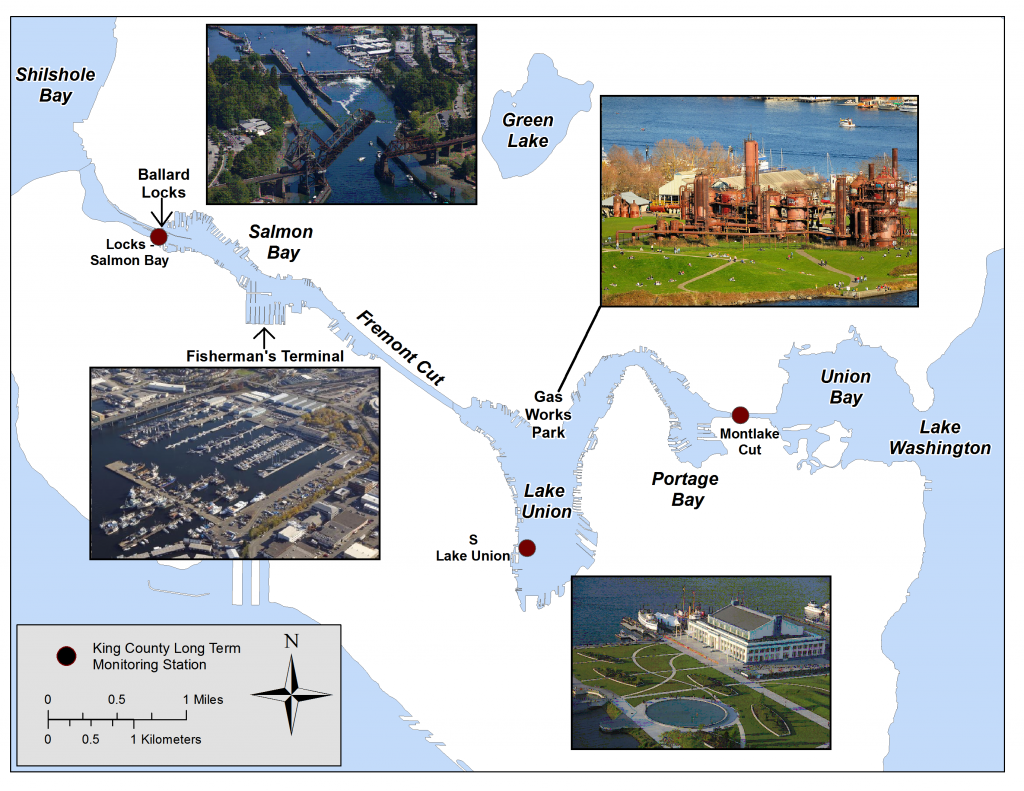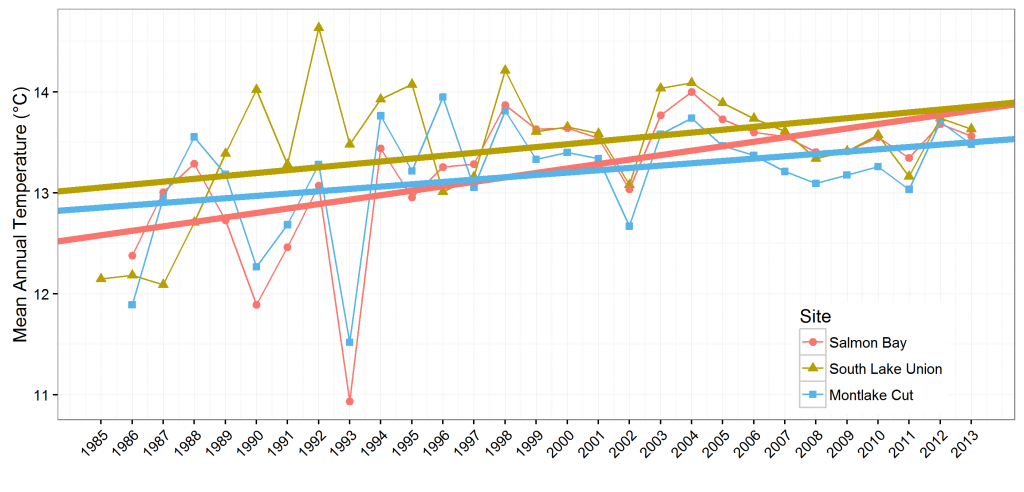by Tim Clark, King County Water and Land Resources Division
Lake Union’s central location in Seattle, its photogenic framing of downtown, and its calm waters make it the ideal setting for Fourth of July fireworks and a hub for kayakers and paddle boarders. Lake Union serves as a migration route for salmon swimming to their spawning grounds in the Lake Washington/Cedar/Sammamish Watershed. The fish ladder viewing window at the Ballard (Chittenden) Locks is one of Seattle’s must-see attractions.
Unfortunately, Lake Union and the Ship Canal were historically subjected to industrial, wastewater, and stormwater pollution for many decades. While water quality has improved substantially since the mid-1970’s, elevated bacteria levels, contaminated sediment, elevated summer surface temperatures, and low oxygen levels combined with elevated salinity in deeper waters during the summer remain issues for the waterbody.
Lake Union and the Ship Canal have been heavily modified. In 1916, the 8.6-mile-long Lake Washington Ship Canal was completed, which included construction of the Montlake Cut, Fremont Cut, and Hiram M. Chittenden Locks (Ballard Locks). The new canal provided the first navigable passage for deep-draft commercial vessels, barges, and recreational boaters between Lake Washington and Puget Sound.
In the middle of the century, dozens of industries surrounded the shoreline and contributed to pollution in the lake. Untreated sewage from hundreds of houseboats and nearby homes, along with untreated stormwater, also contributed to pollutant loading in the lake. As the sewage system became overwhelmed during large rain events, combined sewer overflows released even more untreated sewage.

Annual geometric mean (top) and 90th percentile (bottom) of fecal coliform bacteria levels since 1976.
Since routine water quality monitoring began in 1976, fecal coliform bacteria levels have decreased significantly. Fecal coliform levels still exceed the 90th percentile state water quality criterion, but at a lower frequency and magnitude than during previous decades. Similar decreasing trends have been observed for nutrient levels in the lake.
In the summer, warm surface water temperatures, low dissolved oxygen concentrations and elevated salinity at depth are a concern in Lake Union and the Ship Canal. Warm waters are especially challenging for juvenile and adult salmon who must navigate the Lake and Canal on their way in and out of the watershed. Temperatures have increased significantly since the 1970’s and continued warming is expected due to climate change. The U.S. Army Corps of Engineers, who operate Ballard Locks, are investigating ways to improve temperature conditions for salmon migrating through the Locks, but a long-term solution has not yet been identified.
Sediment analysis in Lake Union and the Ship Canal since the 1980’s confirmed that sediments are contaminated with several toxic chemicals, especially near Gas Works Park, in southeast Lake Union, and throughout Salmon Bay. The most widespread contaminants are metals, such as arsenic, mercury, and silver; tributyltin; polycyclic aromatic hydrocarbons (PAH’s); phthalates (plasticizers); and polychlorinated biphenyls (PCB’s).
Lake Union and the Ship Canal will continue to be important pieces of Seattle’s identity. The urban lake is a reflection of the region’s industrial legacy, but steps taken to restore and protect these waterbodies show the region’s commitment to environmental stewardship and remediation. The region continues to improve management of wastewater and stormwater discharges, and multiple sediment cleanups are underway or planned within Lake Union and the Ship Canal, including near Gas Works Park. King County will continue to monitor Lake Union and the Ship Canal and evaluate changes in water quality resulting from current and future efforts.
This story is excerpted from Tim Clark’s article in the “Sci FYI” newsletter published by the Science and Technical Support Section of King County’s Water and Land Resources Division and printed by permission. Read the full story here: http://your.kingcounty.gov/dnrp/library/water-and-land/science/newsletter/2017/january/lake-union-and-ship-canal-history-pollution.pdf











